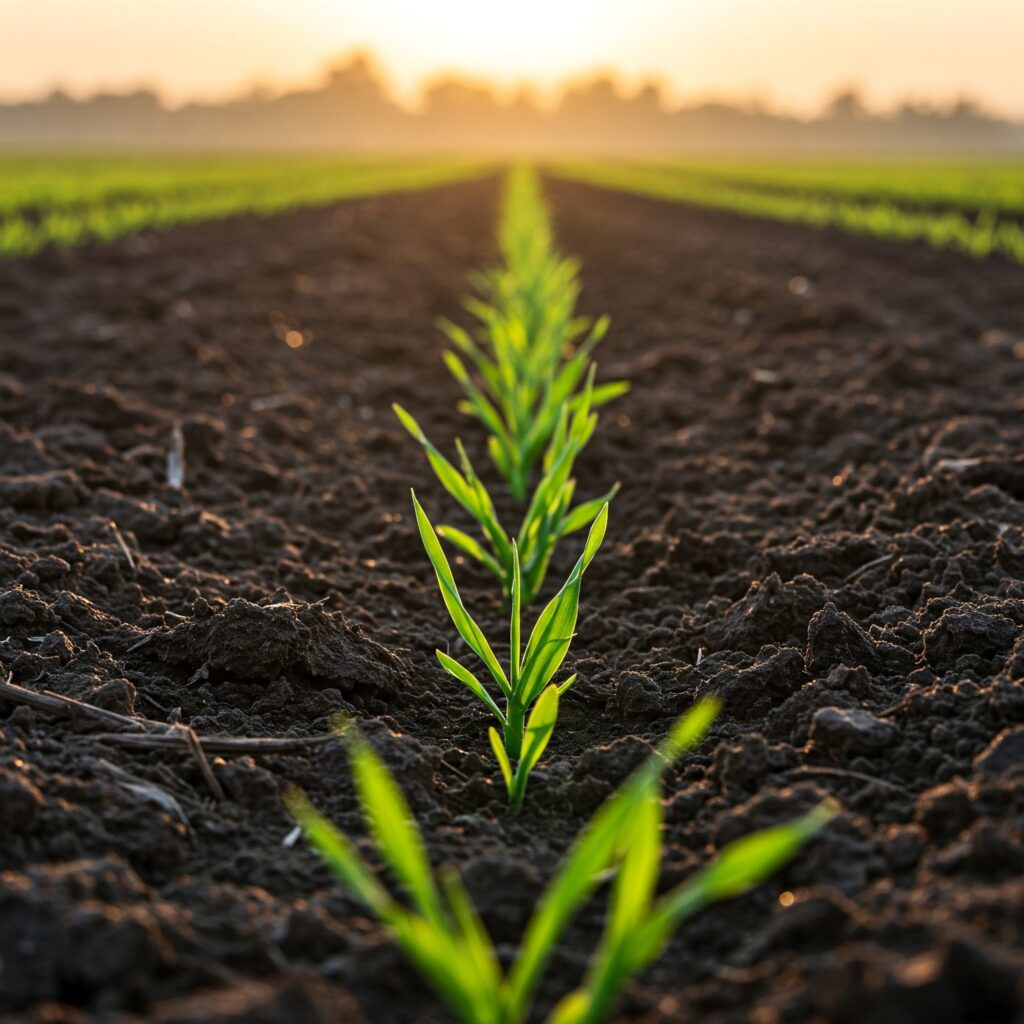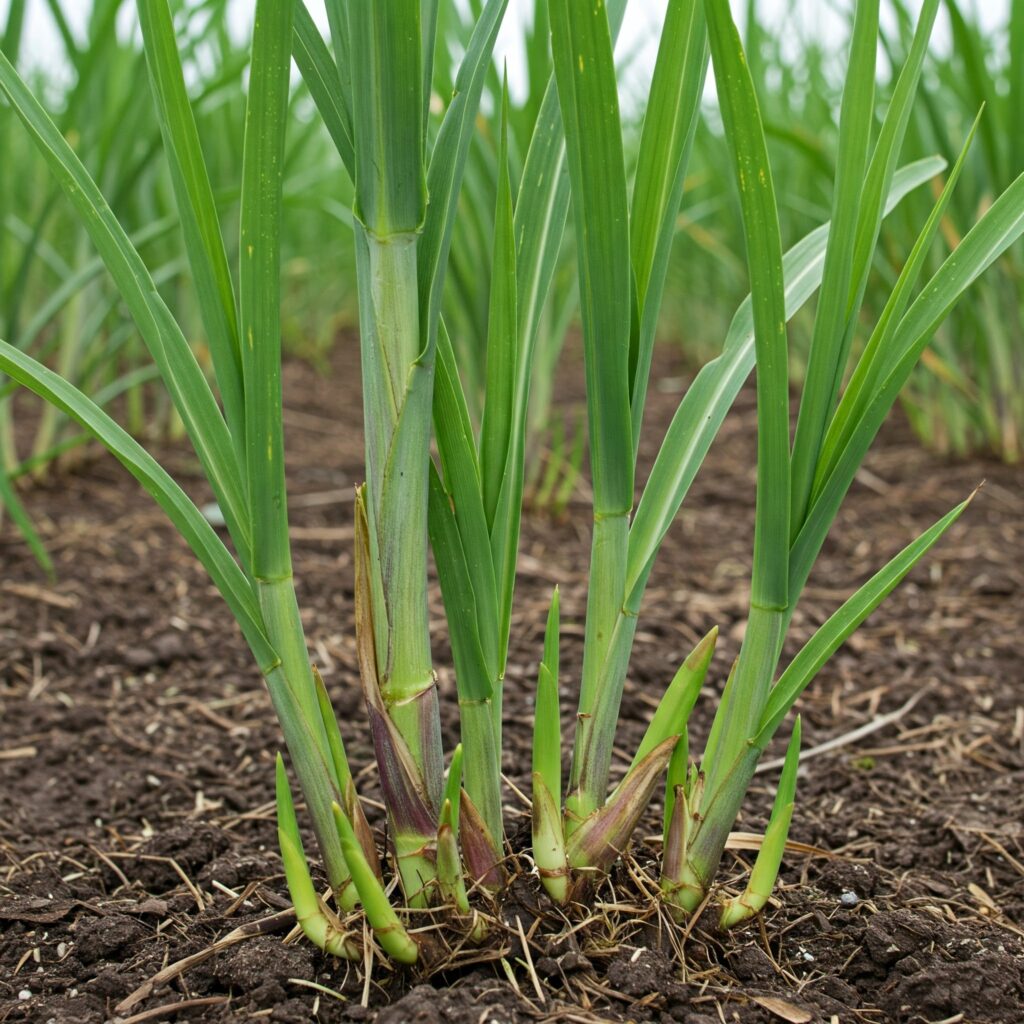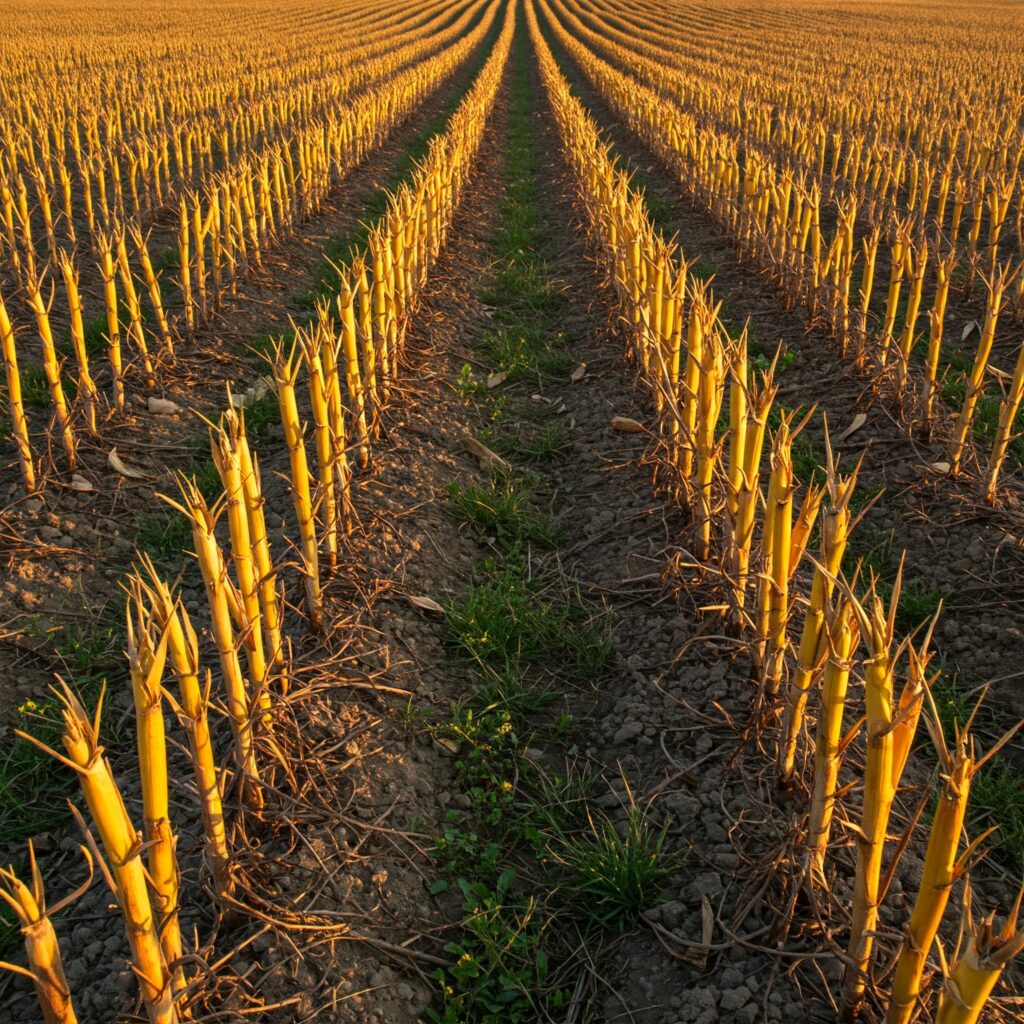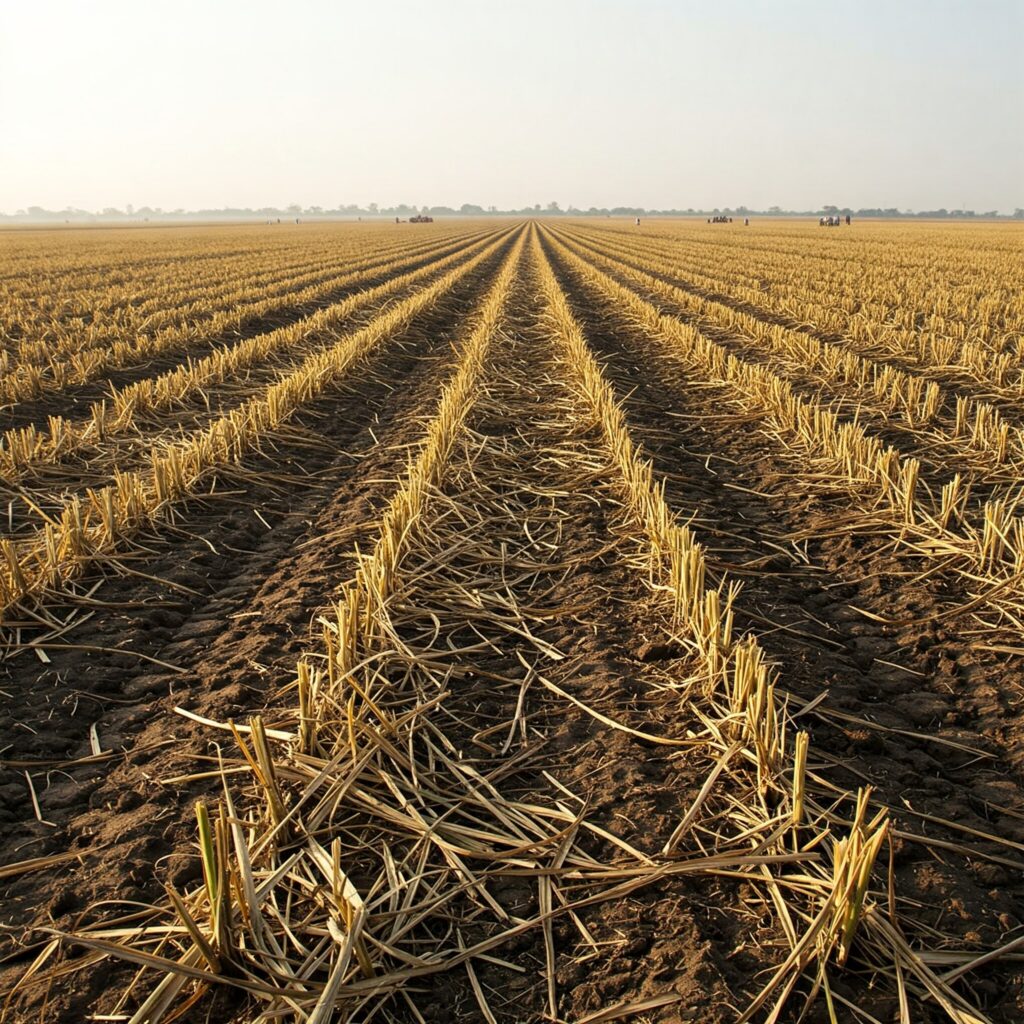Sugarcane (Saccharum officinarum) stands as a crop of vital economic importance in numerous tropical and subtropical regions, driving sugar and biofuel industries. Success in its cultivation is intrinsically linked to a detailed understanding of its distinct phenological stages and the implementation of precise agronomic practices adapted to each phase. This article delves into the developmental stages of sugarcane, offering producers essential technical information and advanced strategies to optimize both yield and the quality of the final product.
Breaking Down the Phenological Stages of Sugarcane for Optimal Harvest
Stage 1: Germination and Initial Sprouting – The Awakening of the Set
The sugarcane cycle begins with the planting of mature stem cuttings, known as sets or “seed.” The rigorous selection of healthy sets, originating from vigorous and disease-free (such as smut and ratoon stunting disease) cane fields, and with an adequate number of viable buds, is the first critical step to ensure uniform germination and successful crop establishment.
A pre-treatment of the sets with broad-spectrum fungicides and insecticides can be a recommended practice to protect them from soil-borne pathogens and early pest attacks, such as the crazy ant or the stem borer. Planting should be done in properly prepared furrows, with a depth and spacing that favor the set’s contact with moist soil and allow unrestricted development of roots and initial shoots. Maintaining consistent soil moisture during the first few weeks after planting is crucial to stimulate germination and rooting.

Stage 2: Tillering – Multiplication of Productive Stalks
The tillering stage is characterized by the emission of new stalks (tillers or shoots) from the basal buds of the main stalk. This process largely determines the stalk density per unit area, a crucial factor for final yield. The intensity of tillering is influenced by the variety’s genetic factors, planting quality, nutrient availability (especially nitrogen), soil moisture, and temperature.
Proper management during this stage can stimulate optimal tillering. Weed control is essential to reduce competition for resources. Timely irrigation and the application of nitrogen fertilizers in appropriate doses favor the emission of new stalks. Occasionally, hilling (covering the base of the stalks with soil) can be done to stimulate greater root development and provide support to the growing stalks.

Stage 3: Stalk Growth or Elongation – Accumulation of Biomass and Height
The stalk growth phase, also known as elongation, is the period of greatest biomass and plant height accumulation. During this stage, the primary stalks and tillers experience rapid vertical growth, driven by photosynthesis and continuous absorption of water and nutrients. The demand for nutrients, especially nitrogen and potassium, is high during this period.
Agronomic management focuses on ensuring an adequate water supply through irrigation, maintaining effective weed control to prevent resource competition, and applying balanced fertilizers according to the crop’s needs and soil or foliar analyses. Pest control for stem borers and disease management for rust and smut remain important to prevent damage that can affect growth and sucrose accumulation in later stages. In areas with a risk of strong winds, staking or tying of stalks can be implemented to prevent lodging, which hinders harvesting and reduces yield.

Stage 4: Maturation or Sucrose Accumulation – Concentrating Sweetness
The maturation stage begins when the vegetative growth rate decreases, and the plant starts to translocate and accumulate sucrose in the stalk. This process is influenced by environmental factors such as decreasing nighttime temperatures, reduced water availability (controlled water stress), and decreasing solar radiation. From a nutritional perspective, a reduction in nitrogen application and an increase in potassium supply can favor sucrose accumulation.
Management during maturation focuses on creating optimal conditions for sugar accumulation. Irrigation may be suspended or significantly reduced to induce moderate water stress. Monitoring sucrose content in the stalks through sampling and laboratory analysis (such as Brix readings) is crucial to determine the optimal harvest time, when sugar concentration is maximum and juice purity is highest. Harvest planning, considering weather conditions and the processing capacity of the sugar mill, is essential at this stage.

Stage 5: Harvest and Ratooning – The Culmination and the New Cycle
Sugarcane harvesting can be done manually or mechanically, depending on the scale of production, terrain topography, and labor availability. Harvest efficiency is crucial to minimize sugar losses and ensure a constant supply to the mill. In manual harvesting, stalks are cut close to the ground and stripped of leaves before being transported. In mechanical harvesting, machines perform cutting, stripping, and loading of the cane.
After harvest, the sugarcane plant has the capacity to produce new shoots from the buds of the underground stubble, giving rise to a new production cycle known as ratooning. Ratoon management is fundamental to maintain productivity in successive cycles. This includes carrying out cultural practices such as cleaning harvest residues, weed control, fertilization, and pest and disease control specific to the ratoon crop. The productivity of ratoons tends to decrease with each cycle, so after several cuts (usually between 3 and 5), cane field renovation with new planting is recommended.

Advanced Strategies to Optimize Production and Quality
Maximizing sugarcane production and quality requires the implementation of advanced agronomic strategies at each phenological stage:
- Precision Agriculture: The use of technologies such as GPS, remote sensors, and geographic information systems (GIS) allows for site-specific management of inputs (fertilizers, water, pesticides), optimizing their use and reducing costs and environmental impact.
- Integrated Pest and Disease Management (IPM): Implementing strategies that combine biological, cultural, genetic, and chemical control in a rational and timely manner helps prevent significant losses without relying exclusively on synthetic pesticides.
- Balanced and Efficient Fertilization: Applying fertilizers based on soil and foliar analyses, considering the specific nutritional needs of each phenological stage, ensures an adequate supply of nutrients and maximizes their use efficiency. The use of controlled-release fertilizers and split applications can improve nutrient uptake and reduce losses due to leaching or volatilization.
- Efficient Water Management: Implementing efficient irrigation systems, such as drip irrigation or fertigation, and scheduling irrigation based on crop evapotranspiration and soil moisture, optimizes water use and prevents water stress.
- Selection of High-Yielding and High-Quality Varieties: Choosing genetically superior varieties adapted to local agro-climatic conditions and resistant to major pests and diseases is a key factor for crop success.
- Soil Organic Matter Management: Incorporating harvest residues, planting cover crops, and applying compost or organic fertilizers improve soil structure, water and nutrient retention, and biological activity, contributing to the sustainability of the production system.
Conclusion: A Comprehensive Approach for Sustainable and Profitable Sugarcane Production
Successful sugarcane cultivation demands a deep understanding of its phenological stages and the implementation of precise agronomic practices adapted to each development phase. The adoption of advanced management strategies, based on science and technology, not only allows for maximizing yields and sugar quality but also contributes to environmental sustainability and the long-term profitability of sugarcane production. Meticulous attention to each stage, from germination to harvest and ratooning, is the key to unlocking the full potential of this important crop.
References:
- Dos Santos Pereira, E. J., Sentelhas, P. C., & Monteiro, R. O. C. (2013). Phenological stages of sugarcane. Sugar Tech, 15(2), 127-131.
- Van Dillewijn, C. (1952). Botany of sugarcane. Chronica Botanica Co.
- [Include other references of specific agronomic and physiological studies on the phenological stages of sugarcane].
- [Cite manuals of good agricultural practices for sugarcane cultivation from research or agricultural extension institutions].
Keywords: Sugarcane, phenological stages, germination, tillering, stalk growth, maturation, harvest, ratooning, agronomic management, fertilization, irrigation, pest control, quality, production, precision agriculture.
 AgronoBlog – Agriculture Blog
AgronoBlog – Agriculture Blog 
